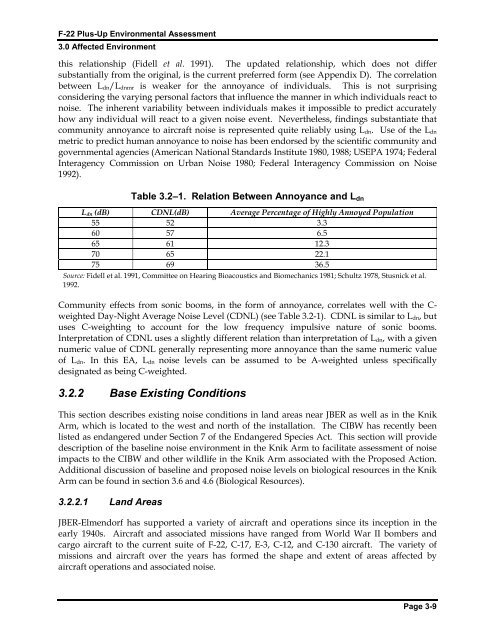F-22 Plus-Up Environmental Assessment - Joint Base Elmendorf ...
F-22 Plus-Up Environmental Assessment - Joint Base Elmendorf ...
F-22 Plus-Up Environmental Assessment - Joint Base Elmendorf ...
Create successful ePaper yourself
Turn your PDF publications into a flip-book with our unique Google optimized e-Paper software.
F-<strong>22</strong> <strong>Plus</strong>-<strong>Up</strong> <strong>Environmental</strong> <strong>Assessment</strong><br />
3.0 Affected Environment<br />
this relationship (Fidell et al. 1991). The updated relationship, which does not differ<br />
substantially from the original, is the current preferred form (see Appendix D). The correlation<br />
between L dn/L dnmr is weaker for the annoyance of individuals. This is not surprising<br />
considering the varying personal factors that influence the manner in which individuals react to<br />
noise. The inherent variability between individuals makes it impossible to predict accurately<br />
how any individual will react to a given noise event. Nevertheless, findings substantiate that<br />
community annoyance to aircraft noise is represented quite reliably using L dn. Use of the L dn<br />
metric to predict human annoyance to noise has been endorsed by the scientific community and<br />
governmental agencies (American National Standards Institute 1980, 1988; USEPA 1974; Federal<br />
Interagency Commission on Urban Noise 1980; Federal Interagency Commission on Noise<br />
1992).<br />
Table 3.2–1. Relation Between Annoyance and L dn<br />
L dn (dB) CDNL(dB) Average Percentage of Highly Annoyed Population<br />
55 52 3.3<br />
60 57 6.5<br />
65 61 12.3<br />
70 65 <strong>22</strong>.1<br />
75 69 36.5<br />
Source: Fidell et al. 1991, Committee on Hearing Bioacoustics and Biomechanics 1981; Schultz 1978, Stusnick et al.<br />
1992.<br />
Community effects from sonic booms, in the form of annoyance, correlates well with the C-<br />
weighted Day-Night Average Noise Level (CDNL) (see Table 3.2-1). CDNL is similar to L dn, but<br />
uses C-weighting to account for the low frequency impulsive nature of sonic booms.<br />
Interpretation of CDNL uses a slightly different relation than interpretation of L dn, with a given<br />
numeric value of CDNL generally representing more annoyance than the same numeric value<br />
of L dn. In this EA, L dn noise levels can be assumed to be A-weighted unless specifically<br />
designated as being C-weighted.<br />
3.2.2 <strong>Base</strong> Existing Conditions<br />
This section describes existing noise conditions in land areas near JBER as well as in the Knik<br />
Arm, which is located to the west and north of the installation. The CIBW has recently been<br />
listed as endangered under Section 7 of the Endangered Species Act. This section will provide<br />
description of the baseline noise environment in the Knik Arm to facilitate assessment of noise<br />
impacts to the CIBW and other wildlife in the Knik Arm associated with the Proposed Action.<br />
Additional discussion of baseline and proposed noise levels on biological resources in the Knik<br />
Arm can be found in section 3.6 and 4.6 (Biological Resources).<br />
3.2.2.1 Land Areas<br />
JBER-<strong>Elmendorf</strong> has supported a variety of aircraft and operations since its inception in the<br />
early 1940s. Aircraft and associated missions have ranged from World War II bombers and<br />
cargo aircraft to the current suite of F-<strong>22</strong>, C-17, E-3, C-12, and C-130 aircraft. The variety of<br />
missions and aircraft over the years has formed the shape and extent of areas affected by<br />
aircraft operations and associated noise.<br />
Page 3-9
















